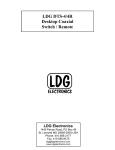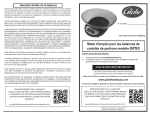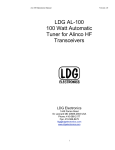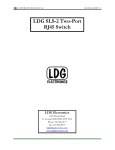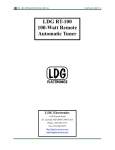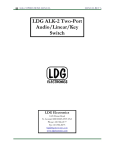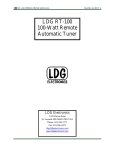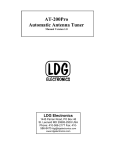Download DTS DTS-6 Specifications
Transcript
LDG DTS-6/6R Desktop Coaxial Switch / Remote LDG Electronics 1445 Parran Road, PO Box 48 St. Leonard MD 20685-2903 USA Phone: 410-586-2177 Fax: 410-586-8475 [email protected] www.ldgelectronics.com 1 LDG DTS-6/6R Desktop Coaxial Switch / Remote Table of Contents Introduction Jumpstart, or “Real hams don’t read manuals!” Specifications Getting to know your DTS-6 2 3 3 3 About the Radio Sense feature Installation Operation 6 7 8 Selecting an antenna 8 Grounding all inputs 8 Setting Radio Sense mode On and Off 8 Application Notes Remote Control Protocol Technical Support Warranty and Service Feedback 8 9 12 12 12 Introduction Congratulations on selecting the LDG DTS-6 desktop coaxial switch. The DTS-6 is a breakthrough product, electronically switching your rig between six antennas, and automatically grounding all inputs when your rig is off. The DTS-6 can be mounted on your operating desk, or operated remotely using the LDG DTS-6R Remote Control. LDG pioneered the automatic, wide-range switched-L tuner in 1995. From its laboratories in St. Leonard, Maryland LDG continues to define the state of the art in this field with innovative automatic tuners and related products for every amateur need. 2 Jumpstart, or “Real hams don’t read manuals!” Ok, but at least read this one section before you transmit: 1. Attach the RF input jack (center connector, marked TX) to your transmitter or transceiver with a 50 ohm coaxial jumper cable. 2. Attach your antennas to the other RF ports. 3. Connect a 12 volt power supply capable of providing 500 ma to the 2.5 x 5.5 mm coaxial power jack (center positive). 4. Press a front panel button to select the desired antenna. Specifications • • • • • Switches up to 1,500 watts of RF power (1000 watts on 6M) Six SO-239 antenna ports Automatic grounding with most modern transceivers (when used with the DTS-6R) Remote operation from DTS-6R or your PC Requires 12 volts at 500 ma, 2.5 x 5.5 mm jack, center positive IMPORTANT SAFETY WARNING Never install antennas or transmission lines over or near power lines. You can be seriously injured or killed if any part of the antenna, support or transmission line touches a power line. Always follow this antenna safety rule: the distance to the nearest power line should be at least twice the length of the longest antenna, transmission line or support dimension. 3 Getting to know your DTS-6 Your DTS-6 is a quality, precision instrument that will give you many years of outstanding service; take a few minutes to get to know it. On the front panel there are six buttons and six LED indicator lights. The six buttons select the six antennas connected to the rear ports. Pressed in pairs, they select special functions. The red LEDs show which antenna is presently selected. For special functions, they blink in groups of two or six. The DTS-6 has no power switch. It powers up when you plug it into the DC supply, and draws current continuously. When no antenna is selected (that is, all inputs are grounded) the current draw is relatively low. On the rear panel, there are seven SO-239 RF connectors. The center connector (TX) is the output to your rig. The other six go to any coax-fed antenna, or to a dummy load. 4 The 2.5 x 5.5 mm jack coaxial DC power connector is on the right. The ground connection is via the wingnut. The control cable input is a 1/8" stereo jack; the control cable is included with the DTS-6R remote. The DTS-6R remote is smaller than the DTS-6, but has the same six switches and six LED lights on the front. On the back, it has the same power, and control jacks, and a radio sense connector, but of course no coax connectors. 5 About the Radio Sense feature Radio Sense is an exclusive LDG feature that automatically grounds all inputs when you turn your radio off. It is available only if you are using the DTS-6 with the DTS-6R remote; the DTS6 by itself does not support this feature. A sense line connects the DTS-6R to any DC output port on your radio providing at least 2 volts DC at 1 ma when the radio is turned on; most modern radios have at least one such DC output. When this mode is enabled, the DTS-6R senses the DC output port go to zero volts when you turn your radio off, and automatically grounds all inputs, protecting the rig from static discharges. When you turn your rig back on, the DTS-6R senses the voltage on the DC output port and automatically selects the antenna you were using when you powered down. You can also manually ground all inputs from the front panel with a single press of the control buttons. 6 Installation The DTS-6 and -6R are intended for indoor use only; they are not water resistant. If you use them outdoors (Field Day, for example) you must protect them from rain. Position your DTS-6 in a convenient spot on your operating desk, as close to your transceiver or transmitter as practical. If you are using the DTS-6R remote, you can position the DTS-6 switch anywhere within reach of the control cable. Connect the input jack (center SO-239 connector marked TX) to your transceiver with a 50 ohm coaxial jumper cable (not provided) of suitable power handling capacity. Connect the coax from your antennas to the input connectors as desired. You can note which antenna is on which port in pencil on the white label panels provided above each button on the front panel. You can also connect a dummy load if you wish. LDG strongly recommends that you use a high-quality, properly installed and grounded lightning arrestor in each antenna line. Connect the ground post (wingnut) to ground. Ideally this will be a dedicated 6' - 8' copper ground rod installed near the operation position, say, just outside the window or door. If this is not possible, a cold water pipe can be used. Connect the DTS-6 to the ground using heavy gauge copper wire or braid. If you are using the DTS-6R remote, connect the provided control cable to the Control ports of the DTS-6 and DTS-6R. Radio Sense is an optional feature of the DTS-6R; your DTS-6 and DTS-6R will work fine without connecting the sense port to your rig. However, if you don't use it you'll be missing out on one of the unit's main advantages. Connect the Radio Sense port on the DTS-6R to any source of DC on your transceiver, transmitter or receiver that is switched on and off with the radio's main power. This is often on a DIN connector on the back of the radio. The DC port must provide at least 2 volts DC at 1 ma, but not more than 20 volts DC. Your DTS-6 requires 12 volts DC at 500 ma. Connect a suitable power supply to the 2.5 x 5.5 mm coaxial DC input jack using the provided 2.5 x 5.5 mm jack coaxial power connector (center positive). The DTS-6R remote also requires 12 volts, at 100ma; you can use the same power supply as the DTS-6 if you wish, providing it can source the total required current. An important word about RF power levels Your DTS-6 is rated up to 1,500 watts of RF power. However, some amateur amplifiers generate RF at even higher power levels. Power levels significantly greater than 1,500 watts will definitely damage or destroy your DTS-6. If the DTS-6 fails due to overload it could damage your transmitter. Always observe the specified power limitation. Caution: High RF voltages may be present on internal components when transmitting. Never operate your DTS-6 with the cover removed. 7 Operation Your DTS-6/6R has no power switch; it powers up when you plug it in. The relay associated with the selected antenna is energized and draws current all the time. Operation is exactly the same whether you use the DTS-6 directly, or remotely with the DTS-6R remote control. Selecting an antenna Never attempt to change antennas while transmitting. If you attempt to do so, the DTS-6 will not switch, and all six LEDs will flash to indicate the error condition. To change antennas, stop transmitting and press the button on the DTS-6 or DTS-6R corresponding to the desired antenna. You will hear a distinct "click" as the relays change state. You can change antennas as often as needed; just be sure to stop transmitting before you press a button. Grounding all inputs To ground all inputs, stop transmitting, then press buttons 5 and 6 together. All ports are grounded; lights 5 and 6 will flash twice to confirm grounding. Never attempt to transmit when the DTS-6 inputs are grounded; your transceiver or transmitter may be damaged. When all inputs are grounded, all four LEDs are out. To unground, simply press the button for the desired antenna. The LED for the selected antenna will light, indicating that it is ungrounded. Setting Radio Sense mode On and Off To set Radio Sense mode on, press buttons 1 and 2 together. All six lights will blink twice to confirm that Radio Sense mode is on. Whenever your rig is off (that is, the DC power port on the radio is off), the DTS-6R will automatically ground all inputs. If you press an antenna selection button while the DTS-6R is grounded in Radio Sense mode, lights 1 and 2 will blink three times to remind you; the antenna will not be selected. To set Radio Sense mode off, press buttons 3 and 4 together. Lights 3 and 4 will blink twice to confirm that Radio Sense mode is off. The last antenna you were using will be automatically selected. Application Notes Your DTS-6 is perfectly suited to mobile use. Simply install it in a convenient location near your operating position, and provide 12 volts DC through a fused line (fuse not included; LDG recommends a 1 amp fast-blow fuse). Or, you can install the DTS-6 in the trunk near your mobile antennas, and use the DTS-6R near the operation position. The DTS-6R also requires a fused power line. Many modern transceivers have a "auto off" function, allowing you to program the rig to turn itself off at a specified time. Using this function along with the Radio Sense function of your DTS-6 insures that the rig will be protected even if you forget to turn it off. At the programmed time (midnight, for example) the rig will switch itself off. With Radio Sense mode enabled, the DTS-6 will then automatically ground all inputs, protecting the rig. 8 Antenna 1 Selected Antenna 2 Selected Antenna 3 Selected Antenna 4 Selected Antenna 5 Selected Antenna 6 Selected Radio Sense On Radio Sense Off Ground All Button Command Summary Antenna 1 Selected Antenna 2 Selected Antenna 3 Selected Antenna 4 Selected Antenna 5 Selected Antenna 6 Selected Radio Sense On* Ant. Selected while in Radio Sense Ground** Radio Sense Off* Ground All* Button Press While Transmitting* All Inputs Grounded * Double Blink ** Triple Blink Indicator Light Summary 9 Remote Control Protocol The control port of your DTS-6 is in fact a serial I/O port compatible with standard USB ports. In the future, LDG may release Windows software and a USB cable enabling you to control your DTS-6 from your PC! In the meantime, this section documents the control protocol; you can write your own software to control the switch. The protocol below describes the dialog between the DTS-6R remote and the DTS-6 switch. Under PC control, the PC program you write would take the place of the remote. Simply open the port, send the appropriate commands as character text strings, and receive and process the replies as desired. Note the space between the letter prefix (M or R) and the numeric code. Example: to select antenna 1, your program would send the characters "R 02" to the switch via the USB connection. Your program would then receive the code "M 02" from the switch, indicating that the switch is set. Codes sent by the DTS-6 switch to the DTS-6R remote: M 00 - Main unit tells remote that buttons 5&6 were pushed. Causes remote to flash LEDs 5&6 twice M 01 - Main unit tells remote that all relays are grounded. Remote turns all LEDs off. M 02 - Main tells remote that antenna 1 is selected. Remote lights proper LED. M 03 - Main tells remote that antenna 2 is selected. Remote lights proper LED. M 04 - Main tells remote that antenna 3 is selected. Remote lights proper LED. M 05 - Main tells remote that antenna 4 is selected. Remote lights proper LED. M 06 - Main tells remote that antenna 5 is selected. Remote lights proper LED. M 07 - Main tells remote that antenna 6 is selected. Remote lights proper LED. M 09 - Not used. M 10 - Main tells remote that the radio sense mode is now off. Remote flashes LEDs 2 & 3 twice. M 11 - Main tells remote that the radio sense mode is now on. Remote flashes LEDs 1 & 2 twice. M 15 - Main sends this when RF is present and a button was pressed or command received. M 17 - Main tells remote that an operation failed because radio sense is on and there is no radio. Remote flashes LEDs 1 and 2 three times. M 18 - Not used. M 19 - Main will force remote to check status of the radio. Remote responds with radio status. M 20 - Main asks remote to do a self-check. Main expects a response of “R 21” to show the remote has started the check. If “R 21” is not received, then Main flashes LEDs 1 and 4. If “R 21” is received, main unit will scroll the LEDs and wait for another response. M 21 - This is sent to the remote when the remote requests a self-check of the main unit. M 22 - After doing a self-check, everything is correct, so main tells remote. M 23 - After doing a self-check, button 1 is stuck, so main tells remote. M 24 - After doing a self-check, button 2 is stuck, so main tells remote. M 25 - After doing a self-check, button 3 is stuck, so main tells remote. M 26 - After doing a self-check, button 4 is stuck, so main tells remote. M 27 - After doing a self-check, button 5 is stuck, so main tells remote. M 28 - After doing a self-check, button 6 is stuck, so main tells remote. 10 Codes sent by the DTS-6R remote to the DTS-6 switch R 00 - Remote is telling main unit that buttons 4&5 were pushed – user wants to ground all antennas. R 01 - Not used. Remote doesn’t give the command to ground all. R 02 - Remote tells main unit that button 1 is selected – user wants to select antenna 1. R 03 - Remote tells main unit that button 2 is selected – user wants to select antenna 2. R 04 - Remote tells main unit that button 3 is selected – user wants to select antenna 3. R 05 - Remote tells main unit that button 4 is selected – user wants to select antenna 4. R 06 - Remote tells main unit that button 5 is selected – user wants to select antenna 5. R 07 - Remote tells main unit that button 6 is selected – user wants to select antenna 6. R 09 - Remote asks main for the current antenna position. Expects a response from main of “M 00,” “M 01,” “M 02,” “M 03,” “M 04,” or “M 05”. R 10 - Remote tells main that the user wants to turn the radio sense mode off. R 11 - Remote tells main that the user wants to turn the radio sense mode on. R 12 - Remote asks main for current radio mode. Expects a response from main of “M 10” or “M 11”. R 14 - Not used. R 17 - Remote tells main that it does not detect radio power. R 18 - Remote tells main that it has radio power. R 19 - Not used. R 20 - Remote asks main to do a self-check. Remote expects a response of “M 21” to show the remote has started the check. If “M 21” is not received, then remote flashes LEDs 1 and 4. If “M 21” is received, remote will scroll the LEDs and wait for another response. R 21 - Remote tells main that its self-check returned no errors. R 22 - After doing a self-check, everything is correct, so remote tells main. R 23 - After doing a self-check, button 1 is stuck, so remote tells main. R 24 - After doing a self-check, button 2 is stuck, so remote tells main. R 25 - After doing a self-check, button 3 is stuck, so remote tells main. R 26 - After doing a self-check, button 4 is stuck, so remote tells main. R 27 - After doing a self-check, button 5 is stuck, so remote tells main. R 28 - After doing a self-check, button 6 is stuck, so remote tells main. 11 Care and Maintenance Your DTS-6/6R switch/remote are essentially maintenance-free; just be sure to observe the power and voltage limits discussed in this manual. Never attempt to change antennas while transmitting; always switch in receive mode. The outer case may be cleaned as needed with a soft cloth slightly dampened in a mild household cleaning solution. As with any modern electronic device, your DTS-6/6R can be damaged by temperature extremes, water, impact or static discharge. LDG strongly recommends that you use a good quality, properly installed lightning arrestor in each antenna lead. You should never have to remove the cover, but if you do, replace it before operating. High RF voltages may be present on internal components. Technical Support We are happy to help you with your product. For detailed tech support, submit our Tech Support form on our web site under Support/Manuals, then Tech Support. You can find us at www.ldgelectronics.com. Warranty and Service Your product is warranted against defects in parts or workmanship for two years from purchase. The warranty does not cover damage due to abuse or exceeding specifications. This warranty applies to the original purchaser only; it is not transferable. A copy of the receipt showing the purchaser’s name and the date of purchase must accompany units returned for warranty service. All returns must be shipped to us pre-paid; we will not accept units with postage due. Please fill out and print the return form from our web site under Support/Manual, then Tech SupportWarranty. If you need to return your unit to us for service, package it carefully, keeping in mind that we will re-use your packaging to return the unit to you. Include a full description of the problem, along with your name, address and a phone number or e-mail address on the web form. Repairs average about 3 to 6 weeks. We will be glad to service your unit after the warranty period has ended. We will notify you of repair charges by phone or e-mail, and bill you after repairs are completed. Feedback We encourage everyone who uses the DTS-6/6R to contact us (card, letter or e-mail preferred) telling us how well it works for you. We are also always looking for photographs of our products in use; we frequently place such pictures on our Web site (www.ldgelectronics.com). 12












